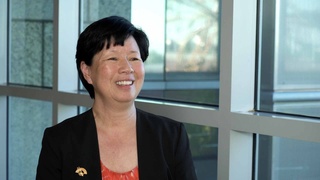Interviews
Different learning style in Japan and the United States
I went to SC (University of South California) evening school to learn English, because I’ve been away for 4, 5 years. In Japan, you never can ask a question. But when I went to SC, the teachers say, “Any questions? Any questions?” and I had so many questions that I could ask. I thought, “Oh this is America”. I was so happy that I could ask questions and be close to the teacher.
But in Japan, it’s different. Very different. You have to learn by watching and they said…it’s bad, but they said, “You have to toru”. “Toru” means “steal,” you know, toru. But that’s how you learn. And so the teacher…you do one thing today but the next day, he does different. And you have to know what different he did. And so sometime his make-up is different. So we have to say, “You’re make-up was different” and that’s why we have to write down in the paper what was different from yesterday.
So we have to be very…and then when practicing, we have to know what the other party…7…you have to know what they’re doing over there. You can’t just learn your part. You have to know the whole what’s going on. So I have to know what you’re thinking. I have to know what he’s thinking. I have to know…that’s kokoro no kukan. “Through the air, you have to feel it.” So that’s what I learned so that when I was in the camp, I could pour my feelings to the audience. And then the response that I get I think is just wonderful. That’s what I think I learned in Japan.
Date: November 30, 2004
Location: California, US
Interviewer: Nancy Araki and John Esaki
Contributed by: Watase Media Arts Center, Japanese American National Museum
Explore More Videos

Parents identification as Peruvian Okinawan
Okinawan American whose parents are from Peru.

The lack of discussion about family’s incarceration in Amache
Sansei judge for the Superior Court of Los Angeles County in California


Her brother’s reasons as a No-No Boy
(b. 1923) Japanese American poet, activist

Her grandfather was pressured to teach Japanese
Sansei judge on the Superior Court of Los Angeles County in California

Neighbor took care of her mother after grandfather was taken by FBI
Sansei judge on the Superior Court of Los Angeles County in California

Immediately after the bombing
(b. 1938) Japanese American. Hiroshima atomic bomb survivor

Other family members not as lucky
(b. 1938) Japanese American. Hiroshima atomic bomb survivor

His parents had little hope that he had survived the atomic bomb
(b. 1938) Japanese American. Hiroshima atomic bomb survivor

His views on nuclear weapons
(b. 1938) Japanese American. Hiroshima atomic bomb survivor

Loss When Leaving for Manzanar
Japanese American animator for Walt Disney and Hanna Barbera (1925-2007)

Forcibly deported to the U.S. from Peru
(b. 1936) Japanese Peruvian incarcerated in Crystal City

Stories of Grandfather at a concentration camp in Fusagasuga
(b.1974) Japanese Colombian who currently resides in the United States

Her grandfather in a concentration camp in Fusagasuga (Spanish)
(b.1974) Japanese Colombian who currently resides in the United States

Family welcomed at Crystal City
(b. 1936) Japanese Peruvian incarcerated in Crystal City
